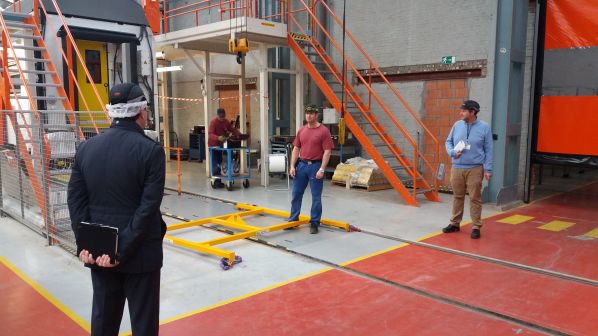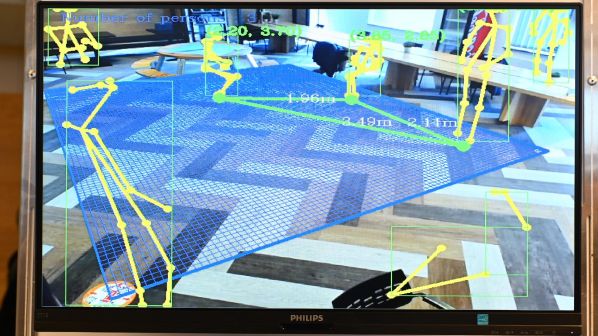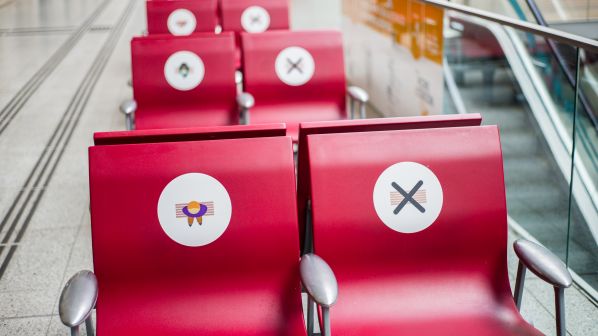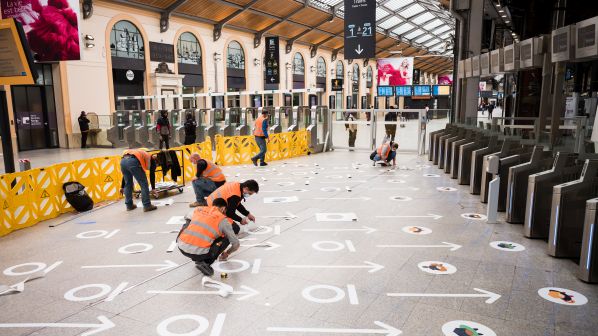SOCIAL distancing is a term that meant little at the turn of the year. However, the events of the last eight months or so have made maintaining a 1-2m distance from those around you a fundamental part of everyday life.
Social distancing conflicts with an underlying strength of rail transport: the ability to carry large numbers of people in a relatively condensed space. Adaptation was therefore essential to address health concerns but also to keep the sector operational.
As Chinese cities and their economies entered lockdown and the virus began to spread around the world in January and February, other countries and industries began working on contingency plans to manage the upcoming disruption.
As Bombardier Transportation’s president of Australia and New Zealand (ANZ), Ms Wendy McMillan maintains close contact with her peers in China and southeast Asia. Bombardier has six joint ventures, seven wholly foreign-owned enterprises and around 7000 employees in China and McMillan says she was in close consultation with Dr Jianwei Zhang, chairman Bombardier China and president, Bombardier Transportation China, in the early days of the pandemic.
“We worked with our worldwide leadership team to support the Chinese operations and learnt from their response,” McMillan says. “The saying goes that if China sneezes, the rest of the world catches a cold. As the Chinese and Southeast Asian operations were responding, we had the window to prepare for what was to come at our other sites.”
Bombardier’s plant at Dandenong, Victoria, employs around 500 people and is currently classified as an essential service by the Victorian government, meaning that operations could continue during the lockdown, which was introduced on March 22 and then reinstated in Victoria in July. McMillan says the early emphasis here was on identifying who was essential for production to continue and who could work effectively from home. For essential workers who remained on site, the priority was to secure the supply of adequate personal-protective equipment (PPE) so they could continue to conduct their daily tasks safely. Proactive management has helped to prevent any cases of Covid-19 at Bombardier’s ANZ sites.
Masks are now required for anyone working in a Bombardier factory and temperature checks are also mandatory for site entrance. And while significant changes have been made to some processes, additional PPE is available for employees who cannot carry out their work outside of the permitted distance.

its Bruges plant.
McMillan says data drove the response, with information on what was working and what was not used to hone the management of social distancing to offer safe working environments while trying to maximise productivity in restricting circumstances.
This vital early experience led to McMillan’s appointment as chair of Bombardier Transportation’s Covid Worldwide task force, which reported to Bombardier Transportation CEO, Mr Danny Di Perna and COO, Mr Jim Vounassis. The team consisted of top management as well as heads of individual regions and countries and would meet via an online video conference to discuss the situation and the company’s response every 24-48 hours.
As the situation evolved, the calls would cover what was happening around the world, country by country, whether there were any cases, the lessons learned, and anything that should be implemented to improve the response.
Unlike at Dandenong, Bombardier did introduce partial shutdowns at other sites, including Crespin, France, and Bruges, Belgium, which are overseen by Mr Laurent Bouyer, president and CEO of Bombardier Transportation France and Benelux.
From the shutdown in Bruges on March 16, Bouyer says his team worked with unions and employees on how they could restart activities, looking at distancing and the protection that needed to be in place. Operations were restarted on April 14 with 20 people and were gradually ramped up until full operation with 400 staff was reached on May 25.
“The saying goes that if China sneezes, the rest of the world catches a cold. As the Chinese and Southeast Asian operations were responding, we had the window to prepare for what was to come at our other sites.”
Wendy McMillan, Bombardier Transportation’s president of Australia and New Zealand (ANZ)
Bouyer says the resumption began with trains that were close to completion, working backwards to the start of the production process. He says the teams analysed all stages of production and areas where distancing might be jeopardised, entirely rethinking the production process, which was reviewed and agreed with employees and unions. He says the concern at the start was that solutions for some processes such as fitting seats or carrying certain equipment, which could require up to four people, would not be found. This was not the case.
“We had to develop some specific jigs to avoid people carrying things together, which required changes to some of the mounting processes, so it would require only two people instead of four before,” Bouyer says. “This means it would take more time to do the same operation, with that time incorporated into a new manufacturing process, so the throughput time would be longer for the train, but at least we would respect the distance and the health measures.”
Bouyer says it is likely to take a couple of years for production at Bruges and Crespin to recover entirely. As well as its own processes, Bouyer says there are delays within the supply chain as other companies also adapt to social distancing-related restrictions. However, Bombardier has supported its suppliers, particularly smaller SMEs, by writing a paper on best practices which was disseminated to local industry.
“We provided a number of recommendations and our ’10 golden rules’ that we have cascaded down so our suppliers can benefit from that and hopefully it would save them some time,” Bouyer says. “70% of our suppliers are located in France, mostly in northern France. In the first two weeks I had six or seven CEOs from local companies calling me to learn about what we did in the incremental phase, learning about how we procure masks, and how we could help them in general. We saw the unity within the supply chain and the railway ecosystem.”
Similar flexibility was required by British infrastructure manager Network Rail (NR). The lockdown in Britain was introduced on March 23 and Mr Rupert Lown, NR’s group HSQE director, says two significant standards on which NR operates were altered in the early days so that the infrastructure manager could continue to deliver an operational railway.
These standards were developed from scratch within 2.5 weeks, which Lown says is unprecedented for NR which normally takes around six months to develop a new standard and three months to roll it out.
“We went out to the market and hired a significant number of vehicles so people could travel in ones and twos, so that they could be socially distanced within a vehicle. That is a fundamental change to the way we operate normally.”
Mr Rupert Lown, NR’s group HSQE director
In the case of Covid-19, these standards sought to empower front line staff in case of impending staffing shortages and also to keep staff healthy and safe while at work. Those who could work from home were allowed to do so, while protocols were adjusted for those conducting tasks in the field. In practice this has led to a multitude of changes in how NR works and the enforcement of social distancing across all areas, including when members of staff are travelling to sites.
“This required a lot of work with trade unions around vehicle use and vehicle design,” Lown says. “We went out to the market and hired a significant number of vehicles so people could travel in ones and twos, so that they could be socially distanced within a vehicle. That is a fundamental change to the way we operate normally with three to four people per vehicle. We also had to segregate people, so one would travel in the front and the other in the back so they remained socially distanced.”
Once on site there were also alterations to certain jobs to help employees maintain social distancing. This included picking up and moving generators used to power tools on site, usually a task for at least two people who would be less than 2m apart.
This process also led to quite a lot of innovation. For example, people came up with ideas for simple lifting devices using poles that could maintain the 2m distance. “Often the teams were able to think of those to become creative,” Lown says. “They were in a position, like a lot of us, that we have never been in this situation before and what could we do here to make it work.”
Training staff to follow these guidelines and providing the oversight to enforce them was another significant undertaking. Lown says technology proved a particularly useful tool to disseminate this information consistently across the entire organisation.
For example, NR managers hosted a number of Webex presentations and online meetings on various topics. These included extensive question and answer sessions, where people were also encouraged to suggest improvements. The ability to record such sessions also meant that staff could tune in where and when it suited them and track the Q&A feed for further clarifications.
In addition, to monitor performance, along with more conventional processes, NR is deploying Yammer - an internal social network platform used for private communication among employees.
“A number of leaders have been in those Yammer feeds, communicating with the front line about concerns or issues or best practices that have been picked up,” Lown says. “So I’m regularly in and out of there, commenting on how people are working and the benefits that it’s bringing.”
Like NR, Belgian infrastructure manager Infrabel has introduced adapted working practices for essential maintenance personnel working in the field to incorporate social distancing. For those in office buildings and communal areas, Infrabel has enforced a variety of social distancing protocols, including one-way systems in buildings.

Interestingly, the infrastructure manager’s IT department is looking to harness ongoing research with Artificial Intelligence applications to monitor workers’ safety on track to reduce possible breaches of social distancing in communal areas in buildings.
A pilot project initiated in the early weeks of the pandemic has successfully developed a monitoring system which offers an acoustic warning when employees breach the 1.5m distancing limit or when the maximum capacity of a specific room or area has been exceeded. Similar AI technology is also detecting whether people are wearing face masks in certain areas, providing an acoustic reminder to the employee to apply the mask.
The system relies on images captured on a simple USB camera and uses a combination of machine learning, computer vision and mathematical homography to effectively transform a two-dimensional image into a three-dimensional image. The system captures the changing position of the person and their limbs to continuously detect the distance between individuals in that area. When people cross the defined boundaries, the system issues the warning.
In order to comply with General Data Protection Regulations (GDPR), individuals are only identified as skeletons by the system. “We use this virtual skeleton to make sure that you could not visually identify the person,” says Mr Terry Wykle, AI project manager at Infrabel. “Also, the local laptop does not store any of this information so there is nothing that will violate anyone’s privacy.”
“Respecting privacy was a fundamental part of the project,” says Mr Dimitri van Hecke, manager support offices at Infrabel. “We did consider other applications such as temperature checks, which can be quite intrusive on a personal level. Even this project could be interpreted in that way - people see a video camera and immediately assume Big Brother is watching. We have to be clear to reassure personnel that this is not the case, to explain the project, what it is doing, and that they won’t be identified.”
The pilot was deployed at six sites initially in the main Infrabel IT building. These trials were set to run to the end of last month at which point a decision on how they might be introduced more widely would be made.
Wykle says the major challenge to delivering the system was the limitations placed on staff working from home. Only basic USB cameras worth e100-200 were used, with teams purchasing these from online retailers for use in the pilot. New methods for brainstorming and deploying the pilot effectively also had to be found and he says a degree of flexibility and creativity to think outside of the box was necessary in challenging circumstances and to deliver results quickly.
This is a lesson replicated at other institutions across the railway industry. McMillan says the flexibility provided by the Microsoft Teams application, which is now in use across Bombardier, was essential to keep people working from home together and to remain on task.
There has also been an emphasis on monitoring individual wellbeing. McMillan says while some employees have taken to working from home well, for others it has been a struggle, particularly when balancing work activities with home commitments.
“Some of our staff are more extrovert than others and they thrive on that social contact, which has become a lot more difficult when they are not in the office,” McMillan says. “We have made sure that the working conditions are fit for task, that they have enough light and are working in a safe environment. There is also the requirement for a daily check in, so they don’t feel and become isolated.”
Bouyer says the added flexibility of working from home for some employees has proven beneficial for the company and will be retained after the pandemic subsides.
“We wanted to emphasise support, help and assistance so passengers feel confident in what we are providing for them.”
Ms Carole Tabourot, director of customer and station services at SNCF Gares & Connexions
“We are proposing to allow staff to work from home 1-2 days per week, providing it is possible and the right safety environment is in place,” Bouyer says. “We realised some of the team were more efficient when they work at home, not having to commute for two hours a day and having the stress of dealing with personal issues, such as arranging childcare.”
Adapting to the new demands of the home office was also a challenge for teams at French National Railways (SNCF) Gares & Connexions and the multi-disciplinary consultancy Arep, which is a subsidiary of Gares & Connexions and provides design services for SNCF. Designers were tasked to come up with adequate signage and wayfinding to enforce social distancing at SNCF’s 3000 stations in just 48 hours ahead of a major increase in service as the lockdown eased in France on May 11.
Gares & Connexion works closely with Arep to enhance the comfort for passengers at stations. Measures were introduced to cover a passenger’s entire journey through the station - from entry, to buying a ticket, using facilities such as shops and toilets, and going to the platform to board the train.
Ms Carole Tabourot, director of customer and station services at SNCF Gares & Connexions, says the project had three objectives: to understand what is happening in the station and the situation passengers are in to meet social distancing protocols; to ensure that passengers are safe and are confident using station facilities; and to get it to work by encouraging a positive response in people to new rules and regulations.
“People understand that this is not a time to be coercive,” Tabourot says. “Instead we wanted to emphasise support, help and assistance so passengers feel confident in what we are providing for them.”
In practice, this meant the production of hundreds of thousands of signs for a variety of uses at stations ranging from small provincial stops to vast city centre terminals.
“For our graphic designers, this was an unprecedented situation,” says Ms Isabelle Lesaux, head of the Arep DesignLab. “The signs had to be easy to understand so people would buy into them quickly and easily… In addition to providing reassuring messages to passengers, they must support passenger flow in such a way that it is smooth and can maintain the proper distance on platforms and at stations.”
Lesaux says there was an emphasis on keeping things simple. Four basic and universally recognised symbols were used: an arrow, circle, a dash and a cross. The teams also designed new pictograms or icons, such as people using their elbow rather than their finger to press a button to activate a door. Close attention was also paid to the colours used. “The main colour was white, which was neutral, reassuring and softer than other colours,” Lesaux says. “The purpose was to have a softer tone and not to be coercive or aggressive with strong and dark colours.”
The second phase of the project was to support station staff to deploy the new signage as intended. This required training so staff understood clearly what the designers were thinking when choosing a certain solution for a specific situation. Again, developers were restricted by having to work from home, communicating online with staff and only visiting two Paris stations in person to take pictures which were used as examples for other stations to follow the protocol.
Of the measures that Tabourot says have proven particularly successful are the circles indicating where people should stand and the white bar to show a line that should not be crossed. The use of a cross to show which benches or seats are not available for people to sit on are also appreciated by users.
Indeed, Tabourot says two-thirds of respondents in Gare & Connexion’s user group said that the messages were easy to understand, were aesthetically acceptable to look at and were reassuring. Lesaux adds that some elements, including the use of arrows to show the direction of travel are proving effective at spreading out people and are likely to remain in place after the pandemic subsides. Other items that have been well received include notices on communal pianos at stations, which say ‘on pause for the moment.’
Signage that has proven less effective include instructions to significantly alter behaviour to an unnatural action, such as using an elbow rather than a finger to open a door or call a lift. Hand sanitiser stations, despite being coloured in yellow to attract attention and strategically located at station entrances and next to toilets, have also been under-utilised. Sticking to social distancing rules is also becoming problematic at larger stations as they become busier. This is likely to intensify as French people embark on their holidays this month.
Flexible working
SNCF is attempting to combat this by announcing platforms for upcoming services up to 40 minutes before trains depart compared with 20 minutes previously. The railway is also encouraging businesses to introduce flexible working hours for employees to spread out the peak.
In addition, teams have tweaked signage at known congestion points. “At the end of an escalator lots of passengers tend to stop to look where they might need to go,” Lesaux says. “We have improved information at the top of the escalator to prevent congestion. For example, we have introduced more arrows on the ground to provide dynamic communication.

“Also, when passengers try to access a platform, there might be multiple entrance points, but they tend to congregate around the first, which quickly becomes overcrowded. We are trying to present more information about other access points or supplementary information about the first. This we have found has offered a 40% improvement in flow of users along the platform.
“We are also using mind mapping solutions to improve the flow of passengers,” Lesaux continues. “We realised from surveys and focus groups with clients that many didn’t know the layout of the station, tending to stick to main entrances and exits, rather than the various entrances and exits that could be used. We have started adding the location of places of interest. So, for Exit 2, you can access bicycles, and at Exit 3, a hotel or post office.”
Enhancing passenger flow to facilitate social distancing has accelerated longer term work at Arep and Gare & Connexions to improve passenger flows at stations. Among the measures is the separation of flows of people entering and exiting stations to avoid crossovers of large numbers of people.
Onboard trains, operators around the world have introduced similar one-way entry and exit practices to separate the flow of passengers. Signage has been used to help to maintain a respectful distance between individuals and groups while seated. Many operators have also limited onboard catering and other services to minimise contact between staff and passengers.
Yet as an airborne virus, there are understandable concerns about remaining in a confined space with other people for a number of hours.
Modern HVAC systems provide a regular flow of clean and fresh air onboard trains, and according to Mr Fernando Hazeu, managing director for Merak, Knorr-Bremse’s HVAC brand, recognition of the importance of air treatment systems and technologies has grown significantly among operators since the start of the pandemic.
The World Health Organisation (Who) encourages the improvement of ventilation with fresh air. Air-conditioning systems, which prevent clogging of air filters and maximise the amount of outdoor air available, are an advantage for rail operators. There are three iterations of clean air technology: optimised air distribution, filtration and purification.
Merak air-conditioning systems feature aerolic architectures which help to minimise transversal airflow in passenger areas. The systems enable injection of air from compartment ceilings and air suction from compartment floors and can purify and renew air flow, for example every six to eight minutes on high-speed trains.
In addition, the systems can be fitted with long-life filters or comprehensive multi-stage filtering which can arrest all particles below 30 micrometres with an efficiency of up to 99%. In addition, Merak’s air purification systems, which use UV-C lamps or more recently, dielectric barrier discharge technology, eliminate residual microorganisms. Tests conducted in 2007 with bacteria and corona-type viruses achieved more than 90% sanitisation after only 30 seconds of exposure and complete absence of bacterial activity on filter surfaces within 30 minutes.
Many of these technologies have been around for a number of years but are not yet universally used onboard rail vehicles. Hazeu thinks that demand is now likely to increase as operators seek to reassure passengers that using the train is safe. For example, the supplier delivered a project in China to install 5000 new HVAC units on 590 high-speed trains. He also believes UV-C systems which have proven popular in eastern Europe, for example, could become more widely used.
Such adaptations reflect the significant changes experienced across the railway industry in recent months as it learns to live with coronavirus. Social distancing measures have presented a fresh set of challenges to the sector and prompted a rapid response that continues to evolve as health legislation changes.
In areas like manufacturing and infrastructure maintenance social distancing has hindered production. Companies like Bombardier must balance expectations of what was possible before and what is realistic now. In other areas, it has sparked improvements in efficiency, and speeded up the adoption of online communications technologies. With rail traffic on the route to recovery, many now hope this will prove the lasting legacy of the coronavirus crisis.

